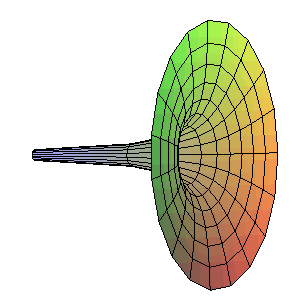


| next surface | previous surface | 2D curves | 3D curves | surfaces | fractals | polyhedra |
GABRIEL'S HORN
 |
 |
 |
| Surface studied by Roberval
and Torricelli in 1641.
Gabriel: archangel (and hornist in his spare time...). Other name: acute hyperbolic solid (name given by Torricelli), hyperbolic funnel. |
| Cylindrical equation: Cartesian equation: Quartic surface. Cartesian parametrization: Volume of the portion obtained for Area of this portion: |
Gabriel's horn is the surface
of revolution obtained by rotating a rectangular
hyperbola around one of its asymptotes.
This surface displays a really surprising paradox: if
we want to fill the tube formed by this surface (which has an infinite
length), we will only need a finite amount of liquid, but if we want to
paint it, we will need an infinite amount of paint!
 |
  |
This paradox can be solved in the following way: we are
assuming that the layer of paint has a constant thickness. But we could
very well paint the trumpet with a finite amount a paint and with the thickness
of the layer going to 0 at infinity. This is precisely what would happen
if we filled the inside with paint!
| The surface, quite close to the previous one, with cylindrical
equation Indeed, it can be proved that the radius r of the trickle of water is given as a function of z (the origin of the axis being at the faucet, the axis pointing downward, |
  |
See also the "Gabriel's
cake", the tower
with constant pressure, and the second
tractroid.
| next surface | previous surface | 2D curves | 3D curves | surfaces | fractals | polyhedra |
© Robert FERRÉOL 2022